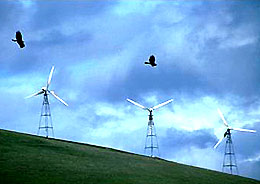|
April 12, 2004
$2 million grant supports efforts to prevent
bird and bat deaths caused by power lines and wind turbines
By Tim Stephens
The California Energy Commission (CEC) has added $2 million to a contract
with the Santa Cruz Predatory Bird Research Group (SCPBRG) aimed at
solving the problem of bird deaths caused by power lines and other electricity
transmission structures. The group has been overseeing research in this
area since May 2002, when it received an initial $1 million grant from
the CEC. The new funding will expand the research program to address
avian and bat fatalities associated with wind-generated power systems.
|

Golden eagles soar near wind turbines at Altamont Pass. Photo
by John Gilardi
|
Thousands of hawks, eagles, owls, other birds, and bats die each year
from interactions with utility structures, including wind turbines,
electrical conductors, and distribution poles.
"Wind turbine mortality is a difficult problem to observe, quantify,
or solve. We are looking for some really innovative solutions to this
potentially significant cause of raptor death in California," said
Brian Walton, coordinator of the SCPBRG, which is based at UCSC.
Wind power is generally considered to be environmentally friendly--it
does not produce harmful emissions, it is compatible with many other
land uses and is relatively inexpensive, and it reduces U.S. dependence
on foreign fuel sources. Some wind farms, however, are responsible for
a large number of bird fatalities, and recent surveys have shown higher
numbers of bat fatalities at newer developments.
One recent study reported that at least 1,000 bird fatalities may occur
every year at Altamont wind farm near Livermore, California. About 50
percent of these losses are raptors, which are protected by the Migratory
Bird Treaty Act, the Bald Eagle and Golden Eagle Protection Act, the
Endangered Species Act, and the California Fish and Game Code. The rate
of bat fatalities due to interactions with wind turbines is unknown,
but some biologists have expressed concerns about the effects of wind
farms on bat populations.
The issue has become more pressing for utility companies in recent
years as the U.S. Fish and Wildlife Service has adopted a tougher stance
toward the industry over the deaths of protected birds. After years
of looking the other way, the agency is now threatening to prosecute
and fine companies for the deaths of protected birds. In 1999, a Colorado
utility cooperative became the first power company to be prosecuted
in federal court for bird electrocutions; the company was fined and
forced to retrofit its wiring.
In California, the state Energy Commission has taken the lead in addressing
these problems.
"UC Santa Cruz has been assisting our efforts to develop effective
solutions, and we felt it was important to expand the program to address
the problems associated with wind power," said Commissioner Art
Rosenfeld, chair of the CEC's research and development committee.
The original program focused on finding effective ways of reducing
bird deaths caused by electrocutions and collisions with traditional
power structures. Under the contract amendment, the SCPBRG will expand
the commission's program to include research aimed at reducing bird
and bat mortality on wind farms. The program now includes research and
development activities in four main areas:
• Risk assessment research to develop and implement methods and
tools to locate and assess energy-related structures that present high
risks for electrocutions and collisions, and to determine the extent
of negative avian and bat interactions in California.
• Risk reduction research to develop and implement standards,
guidelines, tools, and procedures to reduce the extent of negative avian
and bat interactions with energy-related systems.
• Compliance monitoring to develop and implement procedures, guidelines,
and standards for auditing the effectiveness of mitigation efforts.
• Technology transfer to develop media needed by agencies, researchers,
and industry to access and share information intended to promote and
improve bird-safe practices in regard to transmission system upgrade,
maintenance, and design.
The SCPBRG was established in 1975 to restore the endangered peregrine
falcon population in California. The group now applies its expertise
to a wide range of bird species and is working toward creative solutions
for a variety of wildlife management challenges in the western United
States. Additional information about the SCPBRG is available on the
web at http://www.scpbrg.org.
Return to Front Page
|